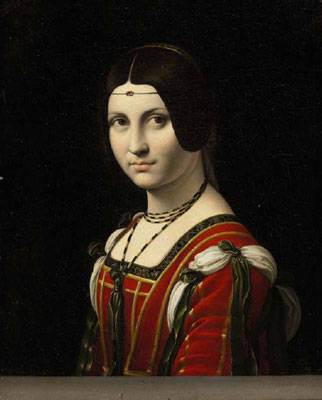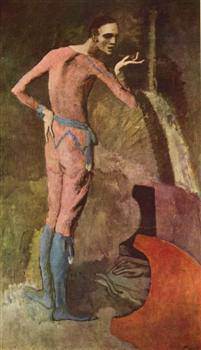
Follower of Leonardo da Vinci, probably before 1750, Portrait of a Woman, Called ‘La Belle Ferronnière’,21 5/8 by 17 1/8 in., 55 by 43.5 cm (est. $300/500,000)
A copy of Leonardo’s ‘La Belle Ferronnière’ at Sotheby’s
On 28 January 2010, Sotheby’s New York will offer a painting that has been at the center of one of the art world’smost heated debates for over eighty years: Portrait of a Woman, Called “La Belle Ferronnière” by a Follower ofLeonardo da Vinci (est. $300/500,000).
]]>
January 12th 2020, source: Sotheby’s
Depicting a lady in three-quarters profile, the portrait is another versionof a composition in the Louvre, now believed to be by either Leonardo or one of his pupils, depicting Lucrezia Crivelli, amistress of Ludovico Sforza, the Duke of Milan. Since the widely publicized 1929 slander trial of the art world’s foremost international expert, Sir Joseph Duveen, La Belle Ferronnière’s attribution has been fiercely contested, raisingquestions of connoisseurship, authenticity, and the role of science in art history in the 21st Century. The picture’sintricate story has fascinated readers for decades; the trial was closely followed by Time and New York Times readers inthe 1920s and is today the subject of a recently published book, The American Leonardo: A Tale of Obsession, Art andMoney, written by John Brewer. After decades out of public view, La Belle Ferronnière will be exhibited at Sotheby’s LosAngeles office on 13 January and at Sotheby’s New York galleries beginning 23 January 2010
La Belle Ferronnière was given as a wedding gift in 1920 to Harry Hahn, an American serviceman during World War I,and his French bride, Andrée. Given by Andrée’s godmother, the painting was believed to be by Leonardo, and hadbeen authenticated by a French art expert, who was, however, not an Italian Renaissance expert. After returning hometo Kansas City, the Hahns endeavored to sell the picture, with a supposed deal in place to sell it to the Kansas City ArtInstitute for the princely sum of $250,000. Sir Joseph Duveen was recognized as the art world’s leading dealer, andhelped craft such famed American collections as those of Andrew Mellon, John Pierpont Morgan, Sr., and John D.Rockefeller Jr. When, on 17 June 1920, a New York World reporter, having heard of the sale of a Leonardo picture,phoned Duveen in the middle of the night for a comment, the venerable art connoisseur declared it was surely a fake.Thus began the battle over the ‘Hahn Leonardo.’ After the deal with the Kansas City Art Institute as well as others fellthrough, Andrée Hahn sued Joseph Duveen for slander and damages of $500,000, claiming that Duveen’scomments were not only false, but designed to drive the picture from the market in his quest for control of the artmarket.
In 1929, Andrée Hahn’s suit against Duveen came to trial in New York State Supreme Court. While the Hahns aimedto affirm their attribution to Leonardo, Duveen argued that not only was the Hahn’s picture not by the Renaissancemaster, but it was in fact a later copy. Duveen, who had rallied a series of highly-respected experts to corroborate hisopinion, expected a handy victory; however, as the trial began, it became clear that the jury was not in his favor. TheAmerican jury had little patience for European experts who offered their superior “eyes” as proof of the painting’sattribution and could provide little concrete evidence. At the trial’s conclusion, the jury was unable to reach a decision,voting nine to three in favor of the Hahns. Sir Joseph Duveen settled out of court before a retrial began, paying AndréeHahn $60,000.
The settlement did little to change the market’s opinion of the authenticity of the Hahn’s picture, however. Duveencontinued to dominate the international art market, and the picture was locked away in a bank vault. In 1946, HarryHahn published his own account of the trial, The Rape of La Belle, in which he lambasts Duveen’s ‘lust for power’ andvengeful attack on the picture. While several private sale attempts were made throughout the second half of thetwentieth century, none were successful and the work disappeared from public view.
The debate over the picture’s authorship has, however, persisted to present day. In 1993, La Belle Ferronnière wasexamined by a leading Leonardo expert, who concluded that while the painting was not by Leonardo, it did in fact haveage, and suggested that it dated to the first half of the 17th Century. Recent scientific analysis of the pigments usedconfirms that conjecture and suggests the work was painted by a French artist, or someone using French materials,before 1750. Such findings are enticing, for they suggest that after over eighty years, La Belle Ferronnière may finallyemerge not only from the shadow of Leonardo da Vinci, but from close to a century of controversy and critical neglect.
Follow us on:


